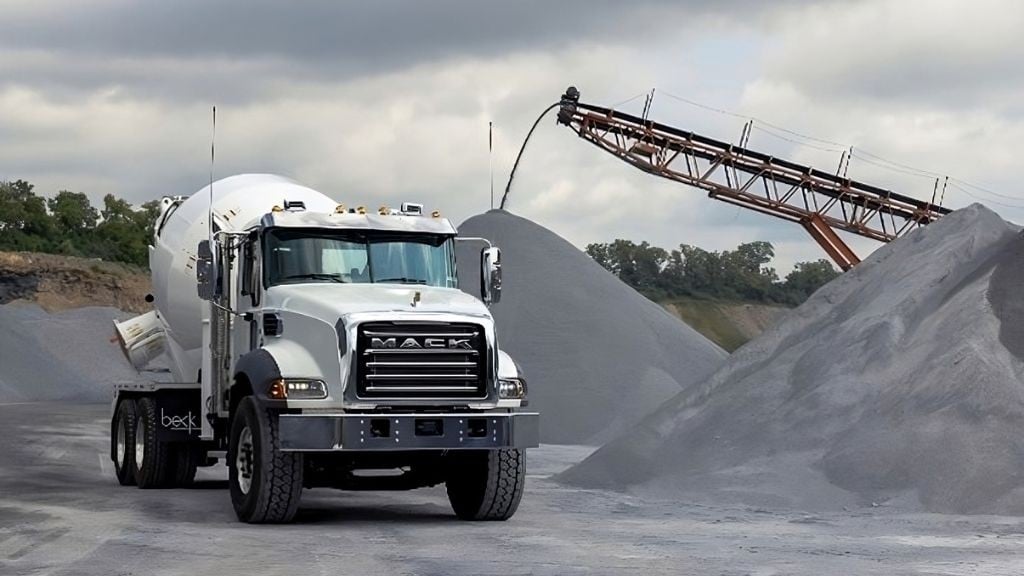Kenworth T880 truck with lighter-weight but powerful package for a range of tasks on many jobsites
Kenworth shows off power pair for vocational uses

When Kenworth launched the T880 truck in 2013, the features and benefits of the new addition to the company’s line were focused towards two areas: building a truck that will get the job done, no matter how challenging, while also offering comfort and safety for the driver. The T880 has become a popular truck for both on-highway and vocational work. The chassis is used as the base for everything from mixers to refuse trucks. Now, it has another benefit for fleet owners: it’s available with the PACCAR MX-11 engine introduced in late 2015. The MX-11 provides operators with a new lighter-weight engine option that still provides a hefty amount of power and torque for challenging jobsite operations.
Kenworth provided trade media an opportunity to test-drive the T880/MX-11 combination during an August event at the PACCAR Technical Center near Mount Vernon, WA. This pairing proved powerful and comfortable in a mix of vehicle uses, even for drivers with little on-road experience.
For this driver, design has gone into providing the occupant with a comfortable and spacious place to work. The T880’s seats neatly absorb any bumps that aren’t handled by the suspension – to the point where even driving over simulated bridge expansion joints at 80 km/h was a little noisy but not terribly jarring.
The seat position has been well designed to give drivers a good vantage point in relation to the road stripes; in fact, visibility from the T880 is excellent all the way around, an important consideration on tight jobsites.
I had the opportunity to drive several different vocational configurations of the T880, including a concrete mixer, two variations on full-sized dump trucks, one with the MX-11 and another with the MX-13. A T370 baby dump was also available for comparison with the larger trucks.
On the road, the first thing that was obvious in all of the vocational trucks was the lack of noise in the cab, along with the overall comfort level for the driver. Gauges are all easily visible, and important switches are all easily reached along the dash.
Next, the responsiveness of the PACCAR engines proved quick and efficient. With a McNeilus 11.5-yard mixer body on the back, the MX-11, generating 430 hp and 1,550 ft.-lbs. of torque, shifted readily and smoothly while pushing the truck to highway speeds and took corners with ease while maintaining speed. The T880 pulling a loaded flatbed proved that the same responsiveness is there even when loaded. Braking was smooth and quick in each of the tested trucks.
Switching over to the Super Dump, the additional power from the MX-13’s 480 hp and 1,650 ft.-lbs. of torque becomes immediately obvious. Whether driven by a professional or amateur, the T880 hit travel speeds with little hesitation. At lower speeds, the truck responded just as well through tight turns and on slopes.
With older drivers retiring and new drivers coming on board for many companies, the need to have easy-to-drive, comfortable trucks is growing among fleet owners. The Kenworth T880 feels much like driving a car, something that should certainly help trucking companies attract and retain drivers.
Adding Bendix Wingman Fusion system to Kenworth T880 and T680 increases safety
The Bendix Wingman Fusion system, available as a factory-installed option on Kenworth T880 and T680 trucks, provides drivers with a range of safety features that run the gamut from alerts to autonomous control of the braking system to reduce the likelihood of serious accidents.
Bendix has taken its expertise in several areas to combine a camera, radar system and its brake technology to create a package that can take over for a driver and react to various road conditions.
“This system is designed to help drivers keep their trips safe and uneventful, and do it with minimal interference,” said Jason Skoog, Kenworth assistant general manager for sales and marketing.
“Bendix Wingman Fusion can help drivers maintain safe distances, mitigate collisions with other motorists who change lanes suddenly, and safely operate in rapidly changing and difficult-to-see conditions like snow, rain, fog, dust, or smoke.”
Bendix demonstrated the Wingman Fusion system on a T680 at Kenworth’s test track. Over several circuits of the course, the driver showed the system’s operation in various scenarios.
Using the camera, Wingman Fusion can read road markings and alert drivers, both visually and audibly, if they drift over lane markings without using their turn signal. If they activate the signal and make that maneuver, the system remains silent. It can also read speed limit signs, and compare them to the truck’s actual speed. If the truck was 5 mph over the limit, an alert sounded. At more than 10 mph above, the driver was alerted and the throttle cut for a second as an additional warning.
Following distance is also measured by the radar and camera combination, with increasingly loud alerts given at certain distances and the brakes autonomously applied to avoid a rear-end accident. Cars cutting in and out of the lane are also recognized by the system, and similar responses are applied if necessary.
The system can also recognize a stopped vehicle ahead and apply the brakes to avoid or mitigate crashes. In the demo, the Bendix air disc brakes brought the truck to a very abrupt stop around 30 feet short of a parked vehicle on the track. Had the driver swerved to avoid, the system would have released the brakes to give the driver control once again.
In addition, all of the information gathered by the system can be transmitted to managers or into telematics systems for driver monitoring and coaching if needed.



